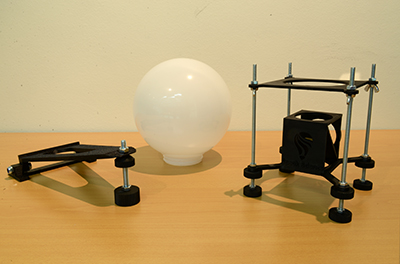
To use Planets in a room you should follow this 8 steps procedure:
Become a member of the Speak Science association and enter the PIAR community: as a first step you should become member of our association and register to the Planets in a room activity for a fee of 30 euro/year. Once you are a member, you will have access to the Private Section of this website (PlanetsInARoom.net). Here, you will have access to the online software needed to calibrate and use PIAR. In this Private section you will also find all the detailed information and plans to build your system, and images and shows to be used with your PIAR system. You will also have access to an online training course about Planets in a room, that will lead from the very steps of the project to customizing your own contents and shows.
Costs: 30 euro/year
3D print the kit and build it: you will find the plans to 3D print the kit in the private section of this website once you became a Speak Science member. You can 3D print the parts on your own, or have them printed in a 3D printing shop or from an online service. You will also need to buy a list of parts and objects, from a detailed list we will provide: nuts and screws (in any hardware shop), a mirror of a specific dimension (we suggest an online shop) and a plastic sphere from a lamp light.
Costs: the costs of the parts you need to buy is less than 50euro. Costs of the 3D printing are variable (from 70 to 150 euro)
Buy/find the 2 lenses: you need 2 commercial lenses to complete the system: a Fisheye 8mm lens and a 50mm lens (see below for more details). You can recycle used camera lenses or buy them in any shop.
Cost: the cost of the lenses is variable. We suggest 2 lenses you can buy on Amazon for about 400euro (ATTENTION! the prices of lenses vary on the market).
Choose a computer and a projector (not dedicated): you need to identify a computer and a projector to be used with your system. The kit is studied to work with most commercial computers and projectors but we suggest to stick with the list of products we have tested the system with (see below). Computer and projector don’t need to be exclusively used with the system, but you will need to re-calibrate the system when changing them.
Cost: for your system, you will need a powerful enough projector, with an approximate cost of more than 500 euro (you can use the projector and computer for other activities!)
Set-up and calibrate the system: you are ready to build, calibrate and set up your system. Please be aware that the first use of Planets in a room requires some work from your side. Please be patient and be aware that once you have the system built, running and calibrated, it will be much easier to use.
Make your show: you can now login in the Private Area of this website to prepare your own show, using existing content or preparing your own customized ones. The library of educational material will grow in time and we recommend to share online your own original contents and your experience with other users, to make our community grow!
Go to planetarium mode (optional): when the system is running, you can bring it under a dome, choose the right full dome contents and use it as a small, simple planetarium projector.
Let the magic work! as a final step, you will only need to turn the system on, choose the selected show… and let the magic of planets and stars enter your room!
SUGGESTED LENSES, PROJECTOR AND PC
The suggested lenses, we already tested with the system are (links are just a suggestion):
Lens 1 - Yongnuo YN 50mm F/1.8 (for Canon EF)
Lens 2 option 1 - Lensbaby 5.8mm f/3.5 Circular Fisheye Canon
Lens 2 option 2 - Peleng 8 mm F3.5 (for Canon EF)
Projectors the system has already been tested with:
Acer models: 6518BD, P1525, H6525BD, P1623, A1500, B150, CE-810, H6511BD, H6512BD, E146D, HE-805J, L552, V62, H6510BD+, P1502, X1623H, P5530, EBFH06
BenQ models (not tested yet but should be working): TH683, W1090, W1110, W2000
The characteristics your projector needs to have, are:
F = 2.59 – 2.87, f = 16.88 mm – 21.88 mm,
1:1.3 Manual Zoom and Manual Focus
max diagonal 762mm@1m
max diagonal 7620mm@7.6m
throw ratio 1.15 – 1.50 (79" @ 2 m)